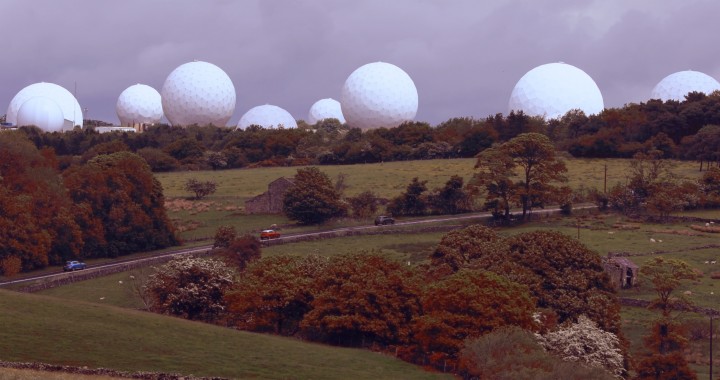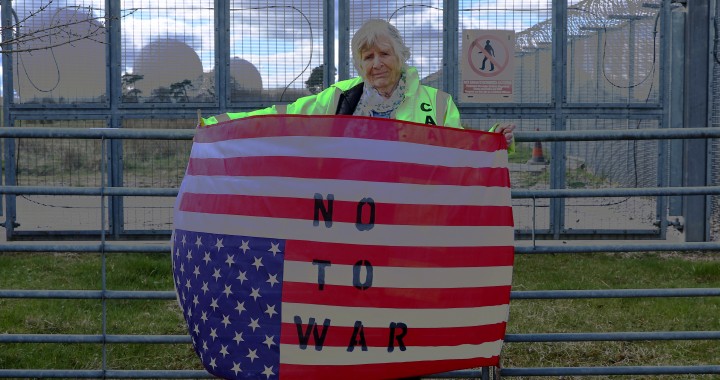Scottish Art News
Latest news
Magazine
News & Press
Publications
A Yorkshire Haunting
By Greg Thomas, 20.02.2023

Andrew Black’s 2021 Margaret Tait Award Commission On Clogger Lane premieres at Glasgow Film Theatre on 21 February. The film excavates a deep history of human habitation in and around Yorkshire’s Washburn Valley, scouring a landscape overlooked by Menwith Hill’s monstrous, surreal satellite surveillance station. From ancient cup-and-ring marks to flooded villages and the hidden graves of adolescent mill workers, On Clogger Lane finds intersecting stories of extraction and exploitation, protest and resistance, and white witchcraft in the nooks and crannies of the dales, tapping reserves of magic in a landscape stultified by capitalism. Vibracathedral Orchestra’s droning, twitching soundtrack musters complementary eldritch vibes and there are cameos from the Greenham Common protest veterans who made a similar cause out of Menwith Hill. Greg Thomas spoke to Black ahead of the screening.
GT: How did On Clogger Lane come about and what are some of the key themes?
AB: I’d made a film in 2019 called Eternity Knocker about Swaledale in North Yorkshire and these three women social historians who had been the first people to really tell the story of the place through the anecdotal recollections of residents....Initially I’d wanted to make that film about a much wider area as there was a lot of social history I was interested in in other parts of the Dales. So that project led to this one.
In the Washburn Valley in North Yorkshire there is a huge military installation called RAF Menwith Hill. It looks like these enormous golf balls on the hilltop. I’m from nearby and you can see it for miles around, but I never questioned it until I saw a video from a whistle-blower at America’s National Security Agency (NSA). He was talking about how tech companies and the state spy on you and he mentioned Menwith Hill. I thought “oh down the road from where I grew up?” So I looked it up and sure enough it’s the NSA’s main base for data gathering....I realised it had to be woven in with the social history I was already looking at. When I started thinking about it I realised you could thread a line from some of the older history of this rural valley to this atrocious military installation and I decided maybe there was something interesting formally I could do.
I had been thinking a lot in the background about British fantasy writing and how much it reflects an emotional fantasy about the country you live in. In particular, I was thinking about 'The Lord of The Rings', which is really just a paranoid fantasy about England. It’s so obvious when you re-read it! It’s also this really attentive study of English folklore and family tradition, of course. I thought: I could conceptualise Menwith Hill as this Barad-dûr-like presence, like Sauron’s Dark Tower overlooking everything.
GT: Did that sense of an alien presence intruding on a local environment inform how the film developed? What else can you tell us about it in formal terms?
AB: Yeah, the image of these huge golf balls sitting over this otherwise very plain, English, agricultural land is the central motif of the film. It’s in two parts, really. The first half involves navigating some anecdotes from local people which reveal different social histories of the valley....For example, the area was sequentially dammed from the 1860s to the 1960s so there are four reservoirs that take up most of the valley bottom and a lot of the millennia-old history of the valley is now underwater....The film also looks into the exhumation of graves that happened when a churchyard was extended in 2008. They found hundreds of very badly damaged children’s skeletons from the late 1800s which turned out to be those of indentured labourers at the flax mills in the valley. The work was violent enough that a significant number were killed.
 Andrew Black, ‘On Clogger Lane’, 2022. Courtesy of the artist.
Andrew Black, ‘On Clogger Lane’, 2022. Courtesy of the artist.
In the second half we start to see the station more and we focus on three women, now in their late seventies and eighties, who established a protest camp at the station in the 1980s-90s as a kind of splinter group from Greenham Common....They’re telling us why we should be concerned about the presence of this thing but also explaining the nature of their opposition to it which is mostly grounded in their sense of local identity.
We tend to see the countryside of the Dales as a benign leisure environment or as a hideaway for very privileged people. I was trying to present a different picture of it, show the other side of the place. It is a working landscape, and there’s been centuries of exploitation but there’s also always been this pushback and dissent.
GT: Is there a biographical impetus to the work too, a sense of wrestling with nostalgia or frustrations of your own?
AB: Yeah, I suppose so, in that I’m making work about what I know about, the place where I grew up. I’m English. I grew up in a relatively middle class context. This is where I’m from. It’s not particularly radical but I reject the idea that the conservatism which is rife in England at the moment, particularly rural England, is the natural order of things. You can find other ways that people were living or conceptualising their communities and I’ve been trying to dig those up.
Also, I’ve lived in Scotland since 2009 and in some way the film is me working through this sense that a lot of people I know have given up on England. Like, we just need to get away because it’s dead....At the end of the film, Sylvia, one of the activists I speak to, challenges me on this and says “I’m afraid I’m English, and I [like] England. This is where I have to take action.”
GT: I was interested in your Lord of the Rings comment. Is fantasy a frame of reference for you?
AB: Yeah though not always explicitly and I take fantasy to mean not only the genre but also a frame of mind, the process of desiring something.... All film is a product of fantasy in a way in that it’s the creation of narrative infused with desire. These films are trying to present a fantasised version of somewhere I know very well, a version reinfused with magic.
I made a community film last year with Atlas Arts in Skye and Lochalsh so of course there was a lot of conversation about Gaelic culture. There are some words in Gaelic that are really fascinating, that don’t really translate but do resonate, such as Dùthchas and dualchas. It’s about your sense of belonging to somewhere but also your responsibility for that place, for the land and the community. It relates to time as well, a sense of belonging that stretches across generations. I was thinking about that and whether you could apply a similar idea to some English communities. In one sense you can’t, of course, because the cultural heritage is so different but are there similar traces that do exist.
There’s also more of a sensitivity within Hebridean communities to the Sìthichean, and sìthein, the fairies, the idea that there are charged places in the land where something more sits, something not within our realm. It sounds sentimental but I’m worried that smartphones and late capitalism have killed the fairies. We’ve sapped the magic from life. We’re all having the same experiences whether we live in Singapore or New Jersey or the Isle of Lewis, but they aren’t real, embodied, emplaced experiences. I do think we need to shrink and re-establish connections to what, and who, is actually around us.
Andrew Black's film On Clogger Lane, previews at Glasgow Film Theatre on 21 Feb, 6:30pm - 7:40pm
On Clogger Lane is also exhibited at The Tetley, Leeds, until 14 May 2023




